FTTR Description
Before we talk about FTTR, let’s talk about what FTTx is.
FTTx is the abbreviation for “Fiber To The x”, referring to “fiber to x”, where x not only represents the location where the fiber arrives, but also includes the optical network equipment installed at that location, and specifies the area served by the network equipment. For example, “H” in FTTH is the abbreviation for “Home”, which refers to fiber optic cable to the home, indoor fiber optic cable to be laid out to the user’s home, and ONU installed at the user’s home. The area served by optical network unit (ONU) is one home. There are other application like FTTB (fiber to the building), FTTC (fiber to the curb), FTTA (fiber to the antenna), FTTP (fiber to the pole), etc.
FTTR is fiber to the room, it is the fiber optic connection to two or more rooms in the user’s home, and the installation of ONU in the corresponding rooms. Each ONU or ONT serves one to more rooms in the home.
FTTR is a new coverage mode for home networks in the gigabit era. It is based on FTTB (Ten Gigabit Era Fiber to the Building) and FTTH (Hundred Gigabit Era Fiber to the Home), and further extends fiber optic deployment to every room, allowing each room to achieve gigabit fiber optic network speed, achieving a new networking solution for full house Wi Fi 6 gigabit coverage.
Why is FTTR required?
In the post pandemic era, with the increasing demand for online learning, work, and live streaming, issues such as poor WiFi coverage, video lag, and slow internet speeds have become common issues for families who are simultaneously studying, working, and broadcasting from home. In addition, with the poor quality of network cables, the increase in building area, and the rapid development of new interconnected applications such as cloud VR, high-definition television, and smart home, urban residents have also put forward higher requirements for the quality of their home networks.
2.1 Current Situation of WiFi Coverage in Houses of Wide Users
The vast majority of home wide users’ indoor WiFi is connected to a router through an ONU and is covered by the router’s WiFi signal.
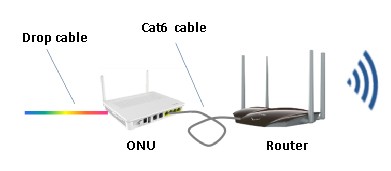
Routers generally support two frequency bands: 2.4G and 5G. Although the 2.4G frequency band can support a maximum rate of 300Mbps, the actual usage effect is much worse due to the high interference in this frequency band. High bandwidth applications for users must use the 5G frequency band, but the ability of WiFi signals to pass through walls in the 5G frequency band is weak, which brings great inconvenience to high-bandwidth applications for some large household users.
The current status of WiFi coverage in users’ homes can be found in the article “Survey of WiFi Network Speed in 39 Wide Users’ Houses”.
2.2 Shortcomings of Existing Whole House WiFi Coverage Schemes
Currently, the whole house WiFi coverage scheme mainly includes three schemes: router cascading, power ONU, and parent-child routing.
The router cascade scheme is to set up a main router at the ONU, and set up a slave router in each room. The master and slave routers are connected by cat6 cables. Due to the limitation of the number of LAN ports on the main router, the number of secondary routers should not exceed 4. If there are more, additional switches should be added at the main router. Due to the use of wired connections, this scheme can ensure gigabit connectivity between the master and slave routes; The disadvantage is that cat6 wires need to be laid inside the house, which has certain implementation difficulties and may affect aesthetics.
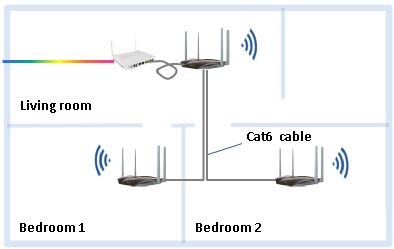
Power ONU are divided into wired power ONU and wireless power ONU. Connect the wired power ONU to the LAN port of the router using a cat6 cable; A wireless power ONU is a wireless router that can be plugged into any power outlet in the house (preferably a wall outlet), and a wired power ONU can be paired with multiple wireless power ONU for use. The signal between wired power ONU and wireless power ONU is transmitted through power lines, and the network speed is greatly affected by the quality of indoor power line wiring for users. Moreover, terminals are often prone to disconnection when roaming in various APs. The drawbacks of electric ONU can be reflected in the sales and user reviews of electric ONU on mainstream shopping websites.
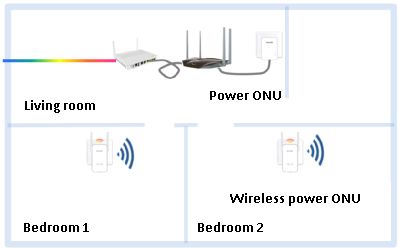
The child to child routing scheme includes one parent router and multiple child routers, and each router can be meshed through WiFi. Due to the difficulty of not passing through walls for WiFi signals between routers, the bandwidth capability of this scheme is greatly affected by the environment. There is a seed and mother routing product that uses WiFi and power lines for transmission between the child and mother routers simultaneously, which has improved the wall penetration ability of WiFi to a certain extent. However, the overall bandwidth capacity still lags significantly compared to the router cascade scheme.
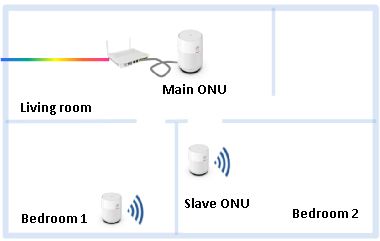
2.3 Advantages of FTTR
FTTR uses one main ONU and multiple slave ONU for indoor WiFi coverage. The main and slave ONU are connected by figure-8 drop cable or invisible optical cables (see the article “Selection of Common Communication Optical Cables”).
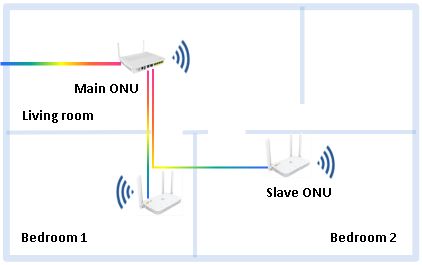
FTTR has the following advantages:
- (1) figure 8 drop cable and invisible cable are easier to lay than Cat6 cables, and the laying of invisible optical cables does not affect indoor aesthetics;
- (2) The maximum network speed near ONU for gigabit users can reach gigabit;
- (3) Stable network speed, stable terminal switching between ONU;
- (4) The lifespan of optical fibers exceeds 20 years, and the bandwidth is almost infinite.
Due to the above advantages of FTTR, the full house WiFi coverage scheme provided by operators is currently being adjusted from the previous mother-child routing scheme to the FTTR scheme, and the most commonly mentioned one is the full house intelligent gigabit fiber.
2.3.1 What is Whole House Intelligent Gigabit Fiber Optic?
The traditional networking solution uses a single ONU and router, and the network cables only reach the weak current box and living room. The WiFi coverage area is limited, and the transmission rate of the network cables is limited, which cannot meet the bandwidth requirements. In addition, after passing through the wall, the signal and network speed are severely attenuated, making it impossible to achieve high-speed WiFi network coverage for the entire family.
The FTTR intelligent gigabit optical fiber in the entire house adopts 10G ONU 1 dragging N mode, which is used for fiber connection in both corridors and rooms. It has strong transmission capacity, higher transmission rate, longer network cable life, and can support 10G uplink, dynamically displaying wide technical signals; The ability to penetrate walls is stronger, reducing signal attenuation, allowing optical fibers to be laid in every room, achieving true full house WiFi 6, gigabit blind spot coverage, and allowing everyone in the family to enjoy the best internet experience brought by gigabit light bands in every location of the home.
In addition to the advantages of fast gigabit fiber optic network speed and no blind spots in the entire house, it can also support 256 terminal device connections, which is 8 times the maximum number of connections in traditional networks (the maximum number of connections in traditional networks is 8-10), effectively ensuring the networking use of various intelligent terminals in the house, such as computers, televisions, mobile phones, tablets, VR, and so on. In addition, in the traditional wiring process, the issue of unsightly wiring can be easily avoided after being updated to FTTR full house gigabit fiber optic. It is compatible with the invention of hidden wire networking, and the wiring is also more beautiful, without damaging the decoration style, and is integrated with the home environment; At the same time, FTTR gigabit fiber optic is particularly suitable for various types of apartments such as large floors and villas over 100 square meters.
FTTR Technical Proposal
According to the different fiber optic connection methods between the master and slave ONU, the technical solutions of FTTR are divided into P2P scheme and P2MP scheme.
3.1 P2P Scheme
The P2P solution is based on Ethernet technology, and the main ONU and each slave ONU are connected through one optical fiber, as shown in the above figure. The main ONU is generally equipped with 4 single core bidirectional optical modules, which can connect up to 4 slave ONUs. The biggest change in this scheme compared to the router cascade scheme is that the cascaded RJ45 interface has been changed to an optical interface, allowing for the use of fiber optic transmission between the master and slave routers. This technology is simple to implement and has low cost, but its scalability is limited.
3.2 P2MP Scheme
The P2MP solution is based on GPON technology. The main ONU is equivalent to a mini OLT, and the configured optical module is the GPON universal Class B+ optical module; slave ONU is the WiFi 6 Gigabit ONU used by GPON currently. 1:5 optical splitter is used in the ODN between the master and slave ONUs. The splitter can be cascaded in multiple stages, supporting up to 16 salve ONUs access.
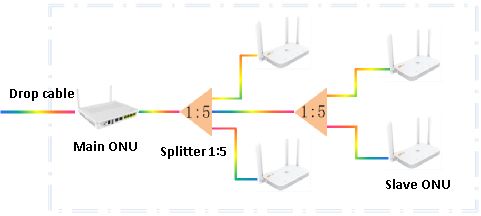
3.2.1 What’s 1:5 splitter?
The 1×5 splitter adopts unequal ratio splitting, with an insertion loss of about 2.0dB between the input and cascade ports, and an insertion loss of about 15.4dB between the input and output ports. Each splitter includes 1 input port, 1 cascade port, and 4 output ports, each of which can be connected to 1 slave ONU.

3.3 Comparison between P2P and P2MP
P2P solutions have simple technology and low prices. Although the number of supported FTTR users is relatively small, the vast majority of users have fewer than 4 FTTR users. So, P2P solutions can basically meet user needs. But precisely because the technology is simple and the entry threshold is low, equipment manufacturers and operators such as Huawei, FiberHome, and ZTE are not willing to promote this solution. Because once ordinary router manufacturers enter this field, FTTR will become a network that users can deploy on their own, like a child parent routing solution, and equipment manufacturers and operators will also lose this cake.
P2MP adopts GPON technology, which saves the layout of optical fibers and supports a large number of optical cats, making it very convenient to increase or decrease the number of optical cats. Although the price of the main optical cat is relatively expensive, due to certain technical barriers, operation and management are more convenient, and it has become the main solution recommended by equipment manufacturers and operators.
FTTR Implementation Case
A Gigabit FTTH user’s house: The fiber ONU and WiFi 6 router are installed at location 1.
The network speeds at points D and F are faster, which are not separated by a wall from the router, while the network speeds at points A, C, and E are less than half of the speeds at point D, which are separated by one wall from the router. The network speeds at points B and G are less than 20% of the speeds at point D, which are separated by two walls from the router,. The network speeds at points B and G are less than 20% of the speeds at point D.

FTTR reconstruction
Install a slave ONU at position 1, 2 and position 3 respectively (the master ONU does not support WiFi), and test the network speed from point A to point G at 5G band and compare with the network speed of FTTH.
In order to test the transmission performance of the slave ONU, the network speeds under “master ONU + router” and “master ONU+ slave ONU (only 1 set)” were tested under FTTH mode.
| Location(Unit:Mbps) | FTTH | FTTH | FTTR |
| Slave ONU | Router | Slave ONU | |
| A | 235 | 221 | 474 |
| B | 121 | 125 | 230 |
| C ② | 240 | 273 | 629 |
| D ① | 620 | 622 | 616 |
| E | 270 | 277 | 368 |
| F ③ | 480 | 440 | 699 |
| G | 45 | 91 | 326 |
From the comparison of the network speed of the two FTTH solutions, it can be seen that in the smaller coverage area, the transmission performance and the mainstream WiFi 6 router are similar. ( The stability of the router is higher than that of the ONU if use multi-terminal access).
In this case, the area of the user’s residence is about 130 square meters, and the household structure is not complicated, and the location of the FTTH ONU and router is relatively moderate, so the comparison of FTTR and FTTH network speed is not very disparate. However, the advantage of FTTR will be more prominent in the large flat and villa with more than 4 rooms and 2 halls, as well as in the duplex house type with larger total area.
Conclusion
Currently, FTTR is mainly promoted by carriers in the form of packages, and some users actually no need. Although the experience of the vast majority of FTTR users has been improved compared to the previous one, the experience of many of them can also be improved through the sub-mother routing scheme.
In future, P2MP will eventually become the mainstream solution in FTTR solutions. The powerful access capability of this solution can even be used for the internal networking of micro and small enterprises, as well as access to larger user groups such as hotels, restaurants and supermarkets. The program, 1:5 unequal splitter multi-level cascade method, can also be used in rural areas and other low-density access scenarios. Look forward to a wider range of applications for P2MP-based FTTR technology.

